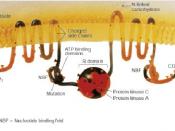Cystic Fibrosis (CF) is the leading fatal genetic disease in the United States, affecting approximately 1 child for 2500 children born (Levine and Miller, 220). This hereditary disorder is most commonly found in Americans who are of European decent. CF affects many parts of human body, such as the reproductive system, digestive system and endocrine system but has its most notable effects on the respiratory system. Essentially the defective gene produces a very thick mucus that clogs the lungs. This in turn, as one can only imagine, leads to many problems with respiration. The following paper will discuss what exactly the defect is, how the gene is inherited, the effects of the disorder on a molecular level, and finally the medical advances and possible treatments for the disorder. Although cystic fibrosis is known to affect many organs of the human, only the effects of CF on the lungs will be discussed in detail.
Cystic Fibrosis is an autosomal recessive genetic disorder (Orenstein, 192). This means that, in order for a child to be affected by CF, his/her phenotype must be homozygous for the CF allele. That is he/she must have received a CF gene from both the mother and the father. If the child received only one CF gene from either the mother or the father then the child is considered to be a carrier and does not express the CF trait. If a couple were to have a child, the probability of the child having/carrying the CF trait can be predicted, given that we know both the couples phenotypes. Unfortunately most carriers of the CF allele are not aware that they are carriers until after they produce a child with CF.
The defect gene itself is caused by irregular pattern of base pairs in the CF gene on chromosome...



Great paper
Great paper and I like the fact that you included your bibliography. It is really hard to find papers that include this and now I can check out these sites and books myself so I can write a better paper. Thank you again.
0 out of 0 people found this comment useful.